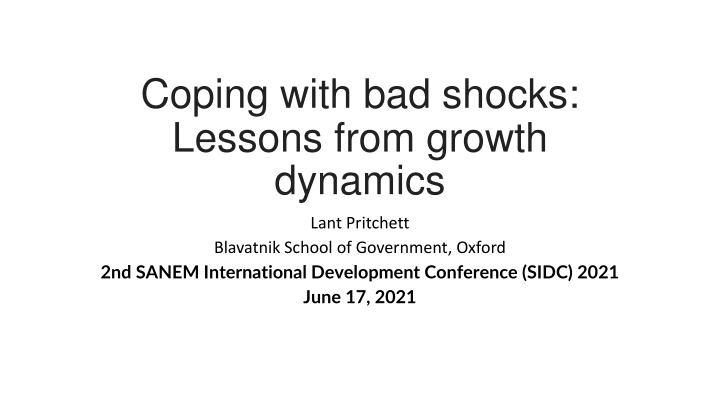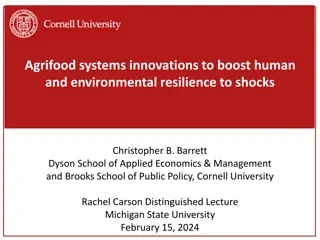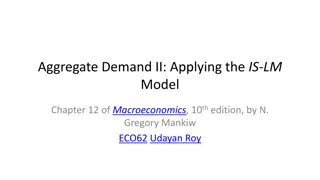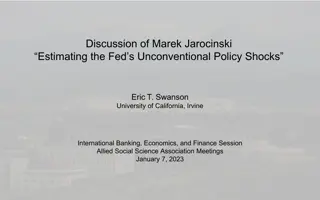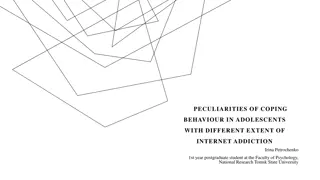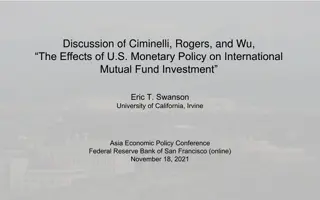Lessons from Growth Dynamics: Coping with Bad Shocks
Delve into the insights on growth dynamics and coping mechanisms for bad shocks in developing countries. Explore the conventional wisdom vs. the actual growth realities and the implications of GDP predictions based on historical trends.
Download Presentation

Please find below an Image/Link to download the presentation.
The content on the website is provided AS IS for your information and personal use only. It may not be sold, licensed, or shared on other websites without obtaining consent from the author.If you encounter any issues during the download, it is possible that the publisher has removed the file from their server.
You are allowed to download the files provided on this website for personal or commercial use, subject to the condition that they are used lawfully. All files are the property of their respective owners.
The content on the website is provided AS IS for your information and personal use only. It may not be sold, licensed, or shared on other websites without obtaining consent from the author.
E N D
Presentation Transcript
Coping with bad shocks: Lessons from growth dynamics Lant Pritchett Blavatnik School of Government, Oxford 2nd SANEM International Development Conference (SIDC) 2021 June 17, 2021
Outline of the presentation Coping with bad shocks: the conventional wisdom based on rich country growth dynamics A fundamentally different reality of growth dynamics for developing countries Facts Underlying theories Are there different lessons?
Start with a question Suppose I had 10 years of GDP data for a country from 100 years ago and I ran a simple trend regression on those 10 years of data and predicted the level of GDP 100 years ahead on the basis of that trend rate of growth. How far off would you expect that 100 year ahead prediction to be (in terms of the absolute value of percent gap between prediction and actual)? {take a minute and write down your guess}
All happy families are alikeOECD countries have had amazing persistence of growth at about exactly 2 percent per capita for over 100 years and hence the future has been remarkably predictable Source: Pritchett & Werker, 2013
Even massive negative shocks for Denmark (like World War I, the Great Depression, and World War II) did not affect the long run level of GPDPC Source: Pritchett & Werker, 2013
The conventional wisdom: (i) shorten the shock (if one can), (ii) borrow to smooth consumption consequences Green: no shock counter-factual Red: Shock to output Yellow: consumption with optimal response, borrow to smooth consumption over time
What a stable grower (oecd happy family) looks like (introduction to set of pictures)
What are actual growth dynamics outside of the OECD Mostly huge volatility within countries over time Some long term very rapid growers Some long term stagnaters
Booms and busts on a downward trend: Nigeria
Table 3: Examples of various types of transition dynamics, using 10 year (overlapping) growth rates Country Proportion of all 5 year (overlapping) growth rates in the growth categories: 2<g<0 (stagnation) Slow growth <2 (collapse) 0<g<2 2<g<4 Moderate growth 4<g<6 Rapid growth 6<g Boom Steady Moderate Growers (sum of category 3 and 4>.9) (27 of 120 countries) 0.000 0.000 0.000 0.000 0.000 0.000 Growth collapses (sum of category1 and 2 > .5) (21 of 120 countries) 0.184 0.474 0.571 0.179 0.643 0.357 Boom and Bust (both the sum of growth states 1 and 2 and the sum of growth states 5 and 6 above .1) (30 of 120 countries) (not mutually exclusive with above, can include collapses if they have booms) 0.000 0.104 0.070 0.209 0.000 0.316 Rapid growth (sum of 5 and 6 above .5) (8 of 120 countries) 0.000 0.000 0.000 0.000 0.000 0.000 Steady moderate growth (OECD and a few) TUR GBR COL 0.417 0.208 0.708 0.583 0.792 0.292 0.000 0.000 0.000 0.000 0.000 0.000 HTI LBR SOM 0.211 0.036 0.000 0.132 0.036 0.000 0.000 0.071 0.000 0.000 0.107 0.000 Stagnater/collapse BRA GHA PNG 0.417 0.419 0.263 0.063 0.163 0.263 0.354 0.023 0.132 0.063 0.116 0.026 Boom and Bust BWA KOR TWN 0.132 0.022 0.000 0.184 0.244 0.128 0.342 0.356 0.298 0.342 0.378 0.574 Rapid growers
What will happen if I dump a bucket of water on my head?
Developing or emerging market countries have phase transitions Everything about the standard macroeconomic decomposition into trend and cycle is unhelpful as growth is episodic The phase transitions are often apparently sharp, discrete, and involve massive and persistent (longer than business cycle ) changes in the underlying growth rate.
This means the expected outcomes from a shock are not confidence it returns to the previous trend path .but that anything can (and does) happen Green: no shock counter-factual Red: Shock to output (with reversion to previous trend) Red Dotted: Shock leads to long term stagnation Red Dashed: Shock leads to downward spiral Red dot-date: Shock leads to response which causes even faster growth Yellow: consumption with optimal response, borrow to smooth consumption over time A time of shock the N (10, 20) year ahead forecast is huge and hence the borrow to smooth strategy is highly uncertain
Two step procedure Break every country in the world s data into the statistically optimal timing of the episodes when were the transitions? (Looking for a break: Identifying breaks in growth regimes (http://ideas.repec.org/a/eee/jmacro/v38y2013ipbp151-166.html) How rapid would have growth been without a break (building in regression to the mean in growth) and hence what were the gains and losses from growth accelerations/decelerations ( Trillions gained and lost )
This produces for every country in the world a dating of the growth breaks and an estimate of the magnitude
Indonesia: Episode from 1967 to 1996, gain of 1 ln unit (actual 4.71 ppa vs 1.22 UCP for 29 years)
Worst 30 deceleration episodes Worst 15 decelerations Next worst 15 decelerations Percent loss relative to UCP predicted -82.7% -69.9% -69.7% -66.2% -65.4% -63.1% -61.6% -60.5% -57.7% -56.7% -51.3% -50.9% -50.2% -50.1% -47.4% Percent loss relative to UCP predicted -44.5% -44.1% -44.1% -43.2% -40.7% -39.6% -39.4% -39.4% -39.4% -37.6% -37.1% -36.6% -35.2% -35.0% -33.8% Percent loss start to finish, actual -61.3% -71.5% -43.4% -71.1% -77.1% -34.0% -45.6% -36.4% -46.7% -48.4% -41.9% -53.2% -50.3% -26.6% -30.8% Ratio end episode to all time low Country 2.22mdg 0.46cub 1.55gnb 0.34uga 0.48bdi 1.52png 2.38alb 1.74zmb 0.62bgr 0.88hti 1.06nic 1.86gha 1.10cog 1.35mng 3.82tcd Percent loss start to finish, actual -42.6% -29.9% -31.0% -35.0% -35.5% -28.3% -39.3% -39.1% -21.4% -34.2% -39.3% -34.8% -27.6% -33.9% -35.4% Ratio end episode to all time low Country Iran afg mwi zar irq jor tto jor som nga cmr gab sle civ rom Period 76-88 86-94 78-02 89-00 79-91 65-74 80-89 82-91 78-10 76-87 84-94 76-87 90-99 78-10 86-94 Period 74-02 84-95 97-10 69-80 92-00 73-84 82-92 75-83 88-97 80-94 87-95 74-83 84-94 82-93 71-80 0.67 1.37 1.10 0.84 1.35 1.23 0.76 0.79 2.09 0.90 0.96 0.94 2.07 1.08 0.72
Ghanacollapse 1974 to 1983, with dramatic recovery but to mediocre growth
Dont confuse what is good for long prosperity with what is good for growth (in medium run)
Weak Institutions (whatever that means) Means Volatile Growth
Political shifts can end disastrously badly: Liberias political transition spilled into complete collapse from above SSA average to 1/5 of SSA average 1200 1000 800 600 GDPPC, 2005 US$ 400 200 0 1950 1960 1970 1980 1990 2000 2010 2020
Growth resilience: Spain has it (big shocks with big recoveries) vs Venezuela doesn t (long negative slide from 1977 to 2002 with boom and bust after and ToT deterioration after a boom turns it into chaos) 35000 30000 25000 WEO October 2015 forecast past 2014 GDP per capita, PPP 20000 15000 10000 5000 0 1950 1960 1970 1980 1990 2000 2010 2020 Source: PWT8.0 plus WEO (past 2010)
Two huge, fundamental, differences in the way understands the growth dynamics of non-OECD countries In countries with generally weak capability for policy implementation one has deals capitalism not rules capitalism and the dynamics of growth in deals capitalism are completely different The capabilities characterization of structural transformation versus the production function characterization the production possibilities
A big conjecture: The dynamics of deals capitalism Deals Capitalism What happens to the typical firm/investor has little or nothing to do with neutral application of policies but is a firm/investor specific deal Closed ordered deals can produce rapid growth rates but block both better institutions and creative destruction Disordered deals cannot protect property rights and hence lead to collapse Dynamics of investor expectations of state transitions can produce wild swings in growth Rules Capitalism What happens to the typical firm/investor is determined primarily by the neutral application of policies This both protects property rights and allows for creative destruction that is, does not protect incumbent rights to existing profits
Typology of deals environments Open Closed (deals depend on actions of agents (including influence activities) but not identities) (deals are available only to specific individuals/organizations deals depend on identities) Ordered (deals done stay done, predictable) Retail corruption (e.g. driver s licenses in Delhi) Cronyism (e.g. Indonesia under Suharto) Disordered (unpredictable what deals are available, deals have uncertain time horizon) Informal sector in many countries Fragile states
From factors to capabilities (Hausmann et al) The export product space The complexity index that measures a countries location in product space Structural transformation that sustains prosperity are moves that increase a country s complexity Complex products are the result of recipes requiring many capabilities especially those that are collectively produced and non- traded
More personbytes Easy to add more Egypt How close are you to other good products in the product space? Many personbytes Hard to add more by just copying others Few personbytes Hard to add more How many personbytes (complexity) do you have now?
Combination of deals and complexity/capability determines joint dynamics of capability and growth High Rent Competitive Export-Oriented RENTIERS Iron ore, gold and diamond miners, tree crop with tax concessions, forestry MAGICIANS Smallholder tree crops, specialized agriculture to Guinea and Ivory Coast Domestic Market POWERBROKERS Legislative monopolies or oligopolies (petroleum distribution, sectors protected for Liberian-only firms), Natural monopolies or oligopolies (beverages, cement), government services (driver s licenses, U.S. dollars through the CBL) WORKHORSES Most importers, traders, retailers, subsistence farmers, transporters, tailors, health care
Lets revisit the conventional wisdom of coping with negative shocks The shorten the shock, borrow to smooth might still be right .but there are three new questions: Can the existing political settlement that sustains the current deals environment for growth survive the shock? (e.g. Liberia) Peru, for very recent instance Does the shock have negative long-run implications for your country s current capability in the export product space? (e.g. is your country long in office real estate (metaphorically) like tourism?) Can my country really borrow enough to not have to worry about the dynamics of the shock?
Uncertainty about what we dont know is what gets us Kay and King revisit Knightian/Keynesian radical uncertainty Puzzles (probabilistic uncertainty) versus mysteries ( what is going on here ) Make sure we don t settle in on the optimal response from an economics of rich countries too soon it might be right, but it is making huge underlying assumptions about the structure of politics/institutions and about production processes 9 so it also might be radically, catastrophically wrong
